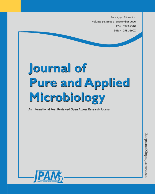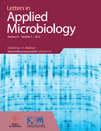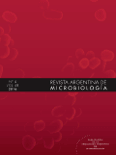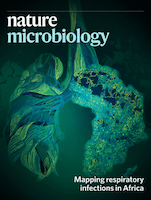
Journal of Pure and Applied Microbiology
Scope & Guideline
Connecting Researchers for a Microbial Revolution
Introduction
Aims and Scopes
- Microbial Diversity and Ecology:
Research on the diversity of microbial communities, including their ecological roles and interactions within various environments, such as soil, water, and human microbiomes. - Pathogenic Microbiology:
Studies on pathogenic microorganisms, their virulence factors, resistance mechanisms, and the clinical implications of infections they cause. - Antimicrobial Resistance:
Investigations into the mechanisms of antimicrobial resistance, patterns of resistance in clinical isolates, and the development of strategies to combat resistant pathogens. - Biotechnological Applications of Microorganisms:
Exploration of microbial applications in biotechnology, including bioremediation, biofertilization, and the production of bioactive compounds. - Food Microbiology:
Research related to food safety, spoilage organisms, probiotics, and the role of microorganisms in food production and preservation. - Environmental Microbiology:
Studies focusing on the role of microbes in environmental processes, including biodegradation, biogeochemical cycles, and the impact of pollutants. - Clinical Microbiology:
Research that addresses the diagnosis, treatment, and epidemiology of infectious diseases, including studies on diagnostic methods and therapeutic interventions.
Trending and Emerging
- Microbiome Research:
A significant increase in studies related to the human microbiome and its implications for health, disease, and therapeutic approaches has been observed, showcasing the importance of microbial communities. - Nanotechnology in Microbiology:
The application of nanotechnology in combating microbial infections and enhancing the efficacy of antimicrobial agents is gaining momentum, leading to innovative therapeutic solutions. - Bioinformatics and Genomic Studies:
There is a growing trend in utilizing bioinformatics tools and genomic approaches to understand microbial genetics, evolution, and interactions, enabling more precise interventions. - Phage Therapy:
Research into bacteriophage therapy as an alternative to antibiotics is emerging as a promising area, particularly in light of rising antimicrobial resistance. - Sustainable Practices in Microbiology:
An increasing focus on environmentally sustainable practices, including bioremediation and the use of microbes in waste treatment and bioenergy production, reflects a broader commitment to ecological health. - Plant-Microbe Interactions:
Research on the interactions between plants and microbes, particularly in enhancing plant growth and disease resistance, is trending as agriculture seeks sustainable solutions.
Declining or Waning
- Traditional Microbial Taxonomy:
Research focusing solely on the classification and identification of microbial species has been declining, likely due to the rise of molecular techniques that provide deeper insights into microbial diversity. - Conventional Antibiotic Testing Methods:
The reliance on traditional methods for antibiotic susceptibility testing has diminished as newer, faster molecular techniques gain traction in clinical and research settings. - Basic Microbial Physiology Studies:
While still important, basic studies on microbial physiology without applied focus are being overshadowed by research with direct implications for health, environment, and industry. - Single-Species Studies:
Research focusing on single species is less common as there is a growing emphasis on understanding microbial interactions within communities and ecosystems.
Similar Journals

ARCHIVES OF MICROBIOLOGY
Championing High-Quality Scholarship in MicrobiologyThe Archives of Microbiology, published by Springer, is a reputable journal in the field of microbiology, serving as a vital platform for the dissemination of groundbreaking research and critical reviews since its inception in 1974. With an ISSN of 0302-8933 and an E-ISSN of 1432-072X, this journal operates out of Germany and maintains a global reach, promoting high-quality scholarship across multiple disciplines, including biochemistry, genetics, and molecular biology, as evidenced by its Q2 ranking in Medicine (miscellaneous) and consistent Q3 placements in other categories in 2023. Although the journal does not offer open access options, its rigorous peer-review process ensures that published articles are of the highest standard, making it an essential resource for researchers, professionals, and students keen on advancing their understanding of microbial sciences. As the journal converges toward 2024, it remains committed to fostering innovative microbiological research and facilitating interdisciplinary dialogue within the scientific community.

LETTERS IN APPLIED MICROBIOLOGY
Advancing the Frontiers of Microbial ScienceLETTERS IN APPLIED MICROBIOLOGY, published by OXFORD UNIVERSITY PRESS, is a prominent journal in the field of applied microbiology, serving as an essential platform for researchers and professionals to disseminate innovative findings. With an ISSN of 0266-8254 and an E-ISSN of 1472-765X, this peer-reviewed journal has been contributing to the scientific community since 1985 and continues to engage with cutting-edge research through 2024. With its current Scopus ranking placing it in the 45th percentile of its category, specifically at rank #70 out of 127 in the Applied Microbiology and Biotechnology field, it underscores its significance in advancing knowledge and applications pertinent to microbial science. Although it is not open access, LETTERS IN APPLIED MICROBIOLOGY offers comprehensive insights aimed at enhancing the understanding of microbiological phenomena in practical scenarios, making it a valuable resource for both seasoned experts and emerging scholars.

Jundishapur Journal of Microbiology
Innovating insights into medical microbiology and public health.Welcome to the Jundishapur Journal of Microbiology, a peer-reviewed publication dedicated to advancing the field of microbiology. Published by BRIEFLAND, this journal focuses on key areas such as infectious diseases and medical microbiology, offering a platform for researchers to share their findings from 2009 to 2024. Despite its current positioning in Quartile 4 across various categories in 2023, the journal provides a valuable resource for budding scientists and established professionals alike, contributing to the growing body of knowledge in these critical areas. While it is not an open-access journal, the Jundishapur Journal prioritizes the dissemination of research in the Netherlands, facilitating a deeper understanding of microbial science and its implications for public health. Join a community of innovators committed to exploring both emerging and established themes in microbiology.

CRITICAL REVIEWS IN MICROBIOLOGY
Navigating the Complexities of Microbial LifeCRITICAL REVIEWS IN MICROBIOLOGY, published by Taylor & Francis Ltd, is a leading peer-reviewed journal that has made significant contributions to the field of microbiology since its inception in 1971. With a prestigious Q1 ranking in Applied Microbiology and Biotechnology, as well as in Medicine and Microbiology, this journal is recognized for its high-quality reviews that synthesize current research and emerging trends in the discipline. Researchers and professionals rely on its comprehensive evaluations and critical insights, helping to advance knowledge and application in various microbiological contexts. Although the journal does not currently operate under an open access model, it remains an invaluable resource for academics seeking to stay at the forefront of microbiological advances. With a consistent publication record, CRITICAL REVIEWS IN MICROBIOLOGY continues to support the scholarly community by addressing key issues and innovations within the field.

REVISTA ARGENTINA DE MICROBIOLOGIA
Connecting experts to foster innovative microbiological insights.REVISTA ARGENTINA DE MICROBIOLOGIA, published by the ASOCIACION ARGENTINA MICROBIOLOGIA, stands as a prominent open-access journal in the field of microbiology and medicine since its establishment in 1979. With an ISSN of 0325-7541 and an E-ISSN of 1851-7617, this journal has paved the way for disseminating high-quality research while enhancing accessibility for academics and practitioners worldwide. The journal has achieved notable rankings, being classified in Q3 for Medicine (miscellaneous) and Q3 for Medical Microbiology in 2023, reflecting its commitment to advancing knowledge in these critical areas. Despite its relatively modest impact factors, it occupies a vital niche in the academic landscape, fostering collaborations and innovative research among experts. With Open Access available since 2013, REVISTA ARGENTINA DE MICROBIOLOGIA not only facilitates widespread distribution of valuable scientific information but also empowers researchers, professionals, and students to stay abreast of the latest findings and developments in microbiology. For those engaged in the evolving realm of microbiology, this journal serves as an essential resource for sharing insights and advancing the scientific community.

Microbiology Research
Connecting Researchers to the Microbial WorldMicrobiology Research, published by MDPI, stands as a pivotal open-access journal in the field of microbiology, having established its presence since 2010. Based in Switzerland, this journal strives to provide a platform for innovative research and cutting-edge findings in various branches of microbiology, including medical microbiology and molecular biology. With an impact factor that reflects its dedication to scholarly excellence, Microbiology Research is classified in the Q3 category for both microbiology and medical microbiology, and Q4 for molecular biology as of 2023, indicating its growing importance and outreach within these domains. The journal aims to foster discussion and collaboration among researchers, professionals, and students by presenting articles that cover a wide array of topics and methodologies in microbiological research. Leveraging its open-access model, Microbiology Research ensures that high-quality research is accessible to a global audience, thus facilitating the advancement of knowledge and innovation in the microbial sciences.

CANADIAN JOURNAL OF MICROBIOLOGY
Fostering Collaboration in the Microbiological CommunityThe Canadian Journal of Microbiology, published by Canadian Science Publishing, is a well-respected journal established in 1954 that serves as a vital platform for advancing knowledge in the fields of microbiology and related disciplines. With an ISSN of 0008-4166 and an E-ISSN of 1480-3275, this journal is recognized for its rigorous peer-review process and its commitment to disseminating high-quality research that spans applied microbiology, biotechnology, genetics, immunology, and more. Currently indexed in several prestigious databases, its impact factor and category quartiles highlight its significance, ranking in the top tiers of applied microbiology and biotechnology as well as other intersecting fields. The journal provides an essential resource for researchers, professionals, and students seeking to stay informed on the latest advancements and breakthroughs, facilitating collaboration and innovation in the microbiological sciences. Set in the dynamic landscape of academia from its headquarters in Ottawa, Canada, the Canadian Journal of Microbiology remains steadfast in its mission to promote research that addresses key challenges and opportunities within the microbiological community.

JOURNAL OF MICROBIOLOGY AND BIOTECHNOLOGY
Advancing the Frontiers of Microbial InnovationJOURNAL OF MICROBIOLOGY AND BIOTECHNOLOGY, published by the Korean Society for Microbiology and Biotechnology, is a premier academic journal based in South Korea that has been at the forefront of advancing knowledge in the fields of microbiology, biotechnology, and their applied sciences since its inception in 1991. This journal holds a commendable Q2 quartile ranking in key categories, including Applied Microbiology and Biotechnology, showcasing its significant impact within the academic community. With an emphasis on high-quality, peer-reviewed research, the journal aims to disseminate innovative findings that foster deeper understanding and advancements in microbial and biotechnological sciences. Researchers, professionals, and students utilize this journal to stay informed about contemporary developments and to inspire future investigations. Although it is not an open-access journal, its content is accessible through various academic libraries and databases, providing a vital resource for those engaged in cutting-edge research.

Nature Microbiology
Empowering Researchers to Shape the Future of MicrobiologyNature Microbiology is a premier journal published by NATURE PORTFOLIO that has firmly established itself within the realms of microbiological research since its inception in 2016. Based in the United Kingdom, this prestigious journal specializes in the intricacies of applied microbiology, cell biology, genetics, immunology, and medical microbiology, making it a cornerstone for academics and professionals alike. With an impressive Scopus ranking placing it in the top tier across various relevant categories—such as rank #3 in Genetics and #2 in Applied Microbiology—it underscores the journal’s commitment to high-quality, impactful research. Although it operates under a subscription model, Nature Microbiology's broad Open Access policy facilitates greater dissemination and visibility for its authors. The journal's objectives are centered around publishing cutting-edge advancements that enhance our understanding of microbial life, its interactions, and applications in health and disease. As a Q1 journal across multiple disciplines, it holds immense significance for researchers, professionals, and students enthusiastic about the latest innovations and breakthroughs in microbiology.

Microbial Physiology
Exploring the Intricacies of Microbial LifeMicrobial Physiology is a premier, peer-reviewed journal published by KARGER, dedicated to advancing the field of microbiology through innovative research and reviews. With an ISSN of 2673-1665 and an E-ISSN of 2673-1673, the journal stands out in the academic landscape having established a strong track record since its inception in 2020, converging its scope until 2024. It proudly holds a Q2 category ranking in several key areas including Applied Microbiology and Biotechnology, Biochemistry, and Microbiology, making it an essential resource for researchers and professionals in these disciplines. The journal provides open access options to ensure that cutting-edge findings are widely disseminated, fostering collaboration and knowledge sharing. As a vital contributor to the ongoing discourse in microbial physiology, the journal serves as a platform for novel discoveries and methodologies that can significantly impact health, industry, and environmental sustainability. Located in Basel, Switzerland, it brings together a global community of scholars eager to further explore the complexities of microbial life.